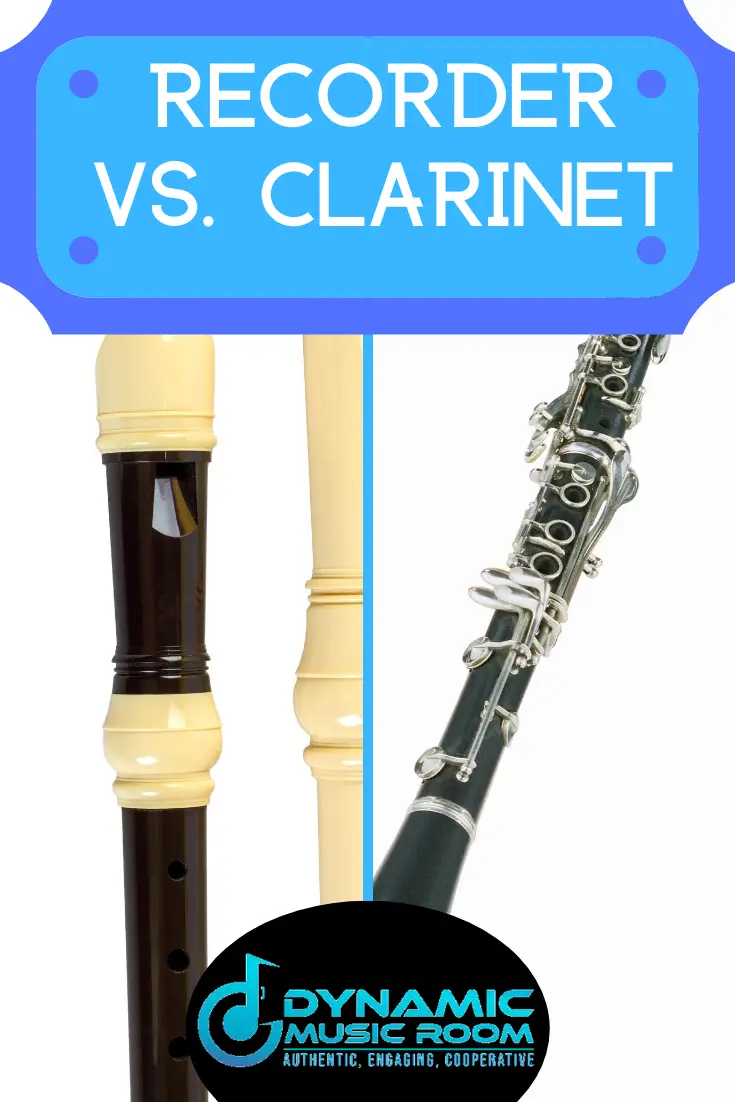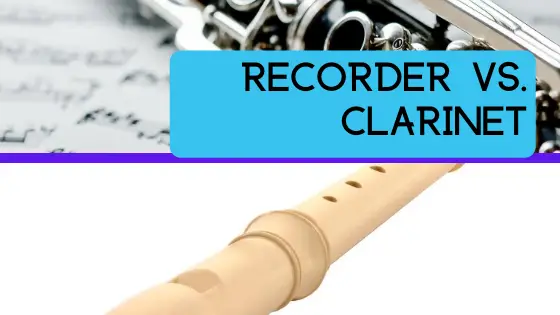Are you thinking about starting clarinet and wonder how your recorder learning will transfer?
Do you want to compare the recorder and clarinet to see how similar they are?
The recorder is an excellent instrument for helping people prepare to play a more “traditional” wind instrument such as the flute, clarinet, or saxophone.
But how much will it help you? In my years of teaching, I’ve explained and discussed this with my students, so I decided to put out this information on recorder vs. clarinet.
The recorder and clarinet have similar designs and functionality including fingerings. However, the clarinet creates sound from a vibrating reed and has different fingerings for its lower notes.
Check out the rest of the post for details on comparing the two instruments.
Table of Contents
Recorder Vs. Clarinet Similarities
There are some key similarities. In this section, we’ll cover these in detail.
Note: This is all assuming we’re talking about the standard baroque recorder.
Learn more about baroque vs. german recorder.
Instrument Family
Both the recorder and the clarinet are part of the woodwind family. This is because the sound created similarly.
I tell my students the name of the “woodwind’ family gives you hints as to how they make their sounds.
The “wood” part implies that there is a piece of wood vibrating to create sound waves. This wood is called a reed.
Reeds are used in clarinets, saxophones, oboes, and bassoons.
The “wind” part implies that its a splitting of the air which creates the sound.
This is done either by a wedge in the mouthpiece or by aiming the air at a flat edge. This is the case with flutes, whistles, and recorders.
Both imply a similar type of vibration creation which is why the clarinet and recorder are grouped in the same family.
Playing Angle
This is an obvious one but still worth pointing out.
The recorder and clarinet are both played straight to the front and angled downward.
The transverse flute plays to the side and the saxophone is to the front but held at a slightly different angle.
For fingering familiarity and positioning, the clarinet is most like the recorder of the woodwind instruments.
Changing Pitches
Both instruments change their pitches in the same.
The body of the recorder and clarinet have holes drilled in them at specific points in the length.
Covering the holes alters the pitches.
Fingering Ideas
In general, fingering ideas are the same.
The more holes you cover, the lower the pitch goes.
The clarinet’s upper register (when the back register key is pressed) is almost the same note for note what the recorder plays.

Recorder Vs. Clarinet Differences
For all the similarities, there are some key differences to watch out for.
Design
The recorder is shaped in a cylinder and the inner tube through which the air travels doesn’t change from the body through to the end.
Learn about the parts of the recorder.
The clarinet is similar, but it does flare out as the tube goes down the end. At the end of the clarinet is a clear bell shape to improve tone, projection, and other aspects of sound.
Use Of Keys
One obvious difference is the use of keys by the clarinet.
It’s larger than the recorder and has more holes for fine-tuning pitches. It’s harder to reach all these holes (impossible for some combinations), so the keys are there to press the right holes for each note.
Soprano recorders don’t use the keys and have less complicated fingerings, but the tenor and bass recorders do also use the key system.
Lower Register Fingering
If the upper notes on clarinet are the same, the lower notes are completely different.
The clarinet is the only woodwind instrument to have their back key be a register key instead of an octave key.
An octave like on the saxophone jumps the notes up one octave. The fingerings don’t change, but the A jumps to the higher A.
A register key like on the clarinet jumps up only partially. The notes don’t stay the same.
The thumbhole on the recorder acts more like an octave key.
Mouth Shape
With the recorder, mouth shape isn’t all that tricky.
Simply cover the mouthpiece with your lips and blow.
The clarinet requires and firm and specific mouth shape to sound good.
Even more, the mouth shape or embouchure changes with different notes.
Learn about how to play the recorder.
Difficulty
The final biggest difference is the difficulty to learn.
Recorders are known for being simple to start on and learn to finger. This is part of why they make great introductions to wind instruments for younger kids.
Clarinets require more work to even make a good sound.
This being said, they aren’t really any easier or harder than flutes, but both are steps above the recorder in terms of difficulty.
Which Should I Start On, Recorder Or Clarinet?
I’ll break it down for you simply in the following chart.
But before the chart, take a look at these two examples of each instrument I recommend.
EASTAR Wood Soprano Recorder
John Paul CL-300 Clarinet
| Your Situation | What I Recommend |
|---|---|
| Under the age of 10 | Recorder |
| 6-10 and willing to take lessons | Clarinet |
| 10-adulthood looking for something fun and easy | Recorder |
| Joining band | Must be clarinet |
| 10-adulthood looking to learn something and dedicate time | Clarinet |
| Low Budget | Recorder |
| Medium budget or above | Clarinet |
Check out the best recorder brands.
Final Thoughts
Now you know more about recorder vs. clarinet.
Their similarities make the recorder a good place to start if the musician isn’t ready to commit to the trickier clarinet. However, many of the fundamentals are different enough the clarinet will still be tricky.
You may wish to check out:

